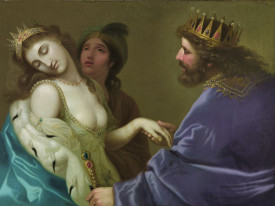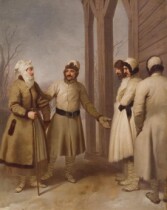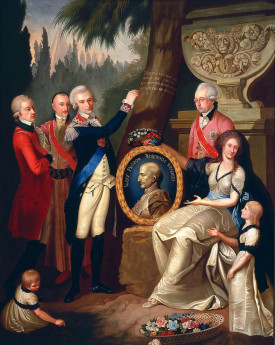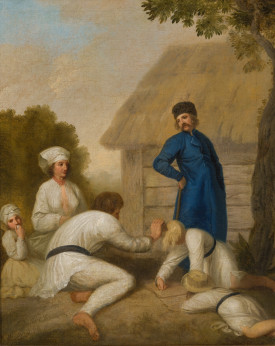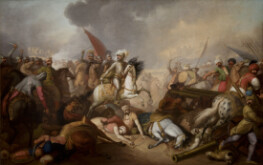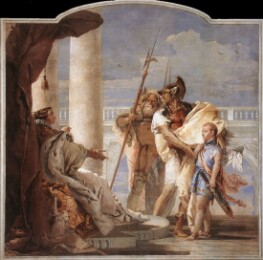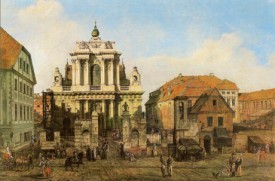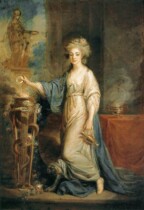Aubrey Beauclerk family in Castel Gandolf
The group portrait depicts the family of Aubrey Charles Fitz-Roy Stuart Beauclerk (1740-1802), an English aristocrat and Duke of Saint Albans, during a visit to Italy. In the second half of the 18th century, portraits of tourists against the backdrop of Italian antiquities, archaeological monuments or Roman buildings became very popular. English intellectuals and aristocrats make up a large proportion of these portraits, since in the 18th century the English considered a trip to Italy, known as the Grand Tour, to be an essential part of a general education. As well as visiting famous monuments from antiquity and beyond, visiting families also collected works of art and were particularly interested in archaeological excavations. In 1779, Aubrey Beclerc, together with his compatriot Thomas Brand, financed an archaeological excavation organised by the painter, antiquarian and dealer in ancient art, Thom Jenkins (1722-1798), near Rome, in the area of the Centocelle (now a quarter of Rome). This excavation unearthed a number of ancient sculptures and other finds that later joined the collections of major museums (for an account of the excavation and the associated paintings by Smuglevičius, see Yarker Jonathan, Hornsby Clara, A Speculative Grand Tour Excavation: Aubrey Beauclerk, Thomas Brand and Thomas Jenkins at Centocelle, in: British Art Journal, 22 March 2011). It is likely that the Beauclerk family met Smuglevičius either through Jenkins or through James Byres of Tonley (1734-1817), a Scottish architect, antiquarian, art dealer and the main English guide to Rome, who had lived in Italy since 1756. Smuglevičius, who arrived in Rome in 1763, had a long-standing relationship with him, which may have begun at the Academy of St Luke's (where Smuglevičius had been a student since 1765 and Byres had been a professor at the art school since 1768). This canvas depicts the Bairs family in a room, the walls of which are decorated with a portrait of the husband and an antique relief. Another portrait of the same family, with the dome of St Patras Basilica in the background, dates from around 1770-1776 and is in a private collection (Brinsley Ford Collection) in London. Smuglevičius may have made the portrait of the Beclerks between the spring of 1779, when the family took up residence in an apartment rented by Thomas Jenkins in one of the villas of Castel Gandolfo (formerly Villa dei Gesuiti, now Villa Torloni), and the spring of 1780, when they departed from Italy. The group of people are depicted in a sumptuous, elegant interior, with the landscape of Castel Gandolfo stretching into the distance through an opening window against a canvas background. Looking at the canvas, it is easy to identify Lady Katerina (seated on the left side of the painting) and the girls - the elder one is drawing at a table, the younger one is playing with her dog. Duke O. Beklerk should be depicted in the centre of the picture, holding out a small ornament, which appears to be a cameo, to his wife. Meanwhile, the person on the right, who is focused on the newspaper, seems less connected to his family. I believe this is a representation of Thomas Jenkins, in whose house, as mentioned above, the Becklers stayed and whose archaeological excavations they supported. "O. The portrait of the Becker family in Castel Gandolfo strikes a perfect balance between the naturalness of the poses and the eloquence of the gestures, and the images of the children are particularly sensitively rendered, with the girl's frank, straightforward gaze as she lifts her head from the drawing becoming the centre of the whole composition. The individuals are portrayed in a portrait-like, individualised manner, and their surroundings are also concrete, but the painting is not domestic, but permeated with allegorical images (the drapery and the column on the right are both an element of a particular terrace and a traditional symbol of luxury, wealth and nobility, the dog is a frequent companion of aristocrats of the time, but is also an old image of fidelity and obedience, etc.). The fine, meticulous manner of the painting, the suggestive materiality of the objects and clothes (especially the silky, shimmering dress of Lady Katerina and her ornate hairstyle) reflect the representational meanings of the portrait, but the overall palette of muted colours, the abundance of greyish, pearly tones, create a gentle, intimate mood. (by Dr. Rūta Janonienė).


